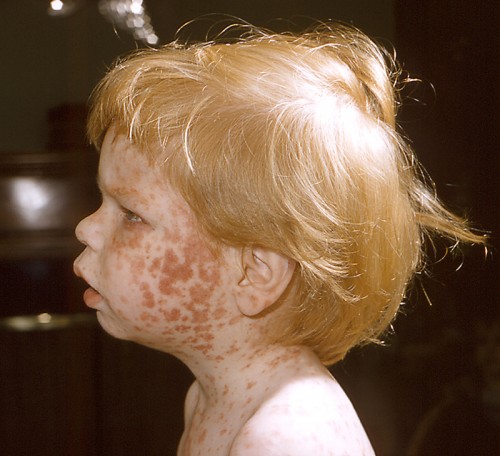Numbered Diseases of Childhood: THIRD Disease – Rubella
This is the fourth of our chats about “the Numbered Diseases of childhood” proposed in 1905 to list all the (then known) diseases which caused rashes and were killing off a sizeable portion of the population each year. Today we’re on ‘ol “Number Three” – Rubella!
Rubella rash on face and neck of child.As we’ve said, it was a great idea while it lasted, trying to make it easier on everyone; but it just “didn’t scale well” as increasing diagnostic sophistication allowed more and more diseases to be split off from the massive general lump of rashes doctors were seeing and trying to understand.
First and second diseases (Rubeola and Scarlet Fever) were already in recorded history in the 1700’s, Rubella was also being seen but was lumped in as part of the others until 1881 when it was accepted as a separate entity: THIRD disease.
Unfortunately, the name chosen: Rubella (roo bell ah, “little red”, THIRD disease) is so close to Rubeola (roo bee oh la, FIRST disease) that it has caused a huge amount of confusion in the English speaking world.
Both of them were initially described in Germany by German doctors but Rubella (THIRD disease) is known as the “german measles,” “three-day measles” or “little measles” and is NOT the same as the “hard measles” of FIRST disease. They have nothing to do with each other.
Spanish even gets it more mixed up: “rubeola” refers to rubella and “sarampión” refers to measles – a case where leaving them back as numbers would have been a lot better. This article is about THIRD disease, Rubella – the one that can be congenital and cause significant birth defects (see below).
THIRD Disease – Rubella
If FIRST disease was called “Hard Measles or 14-day measles” and THIRD disease is called “Easy Measles or 3-day measles” then this must be no big deal – right? Absolutely NOT! This sucker likes to deform babies! We call that teratogenic.
Contagion and Spread
We need to point out that Rubella takes two forms, even though caused by the same virus: acquired and congenital. The former creates a barely noticeable disease, the latter entails a range of serious, incurable illnesses – including death of the fetus.
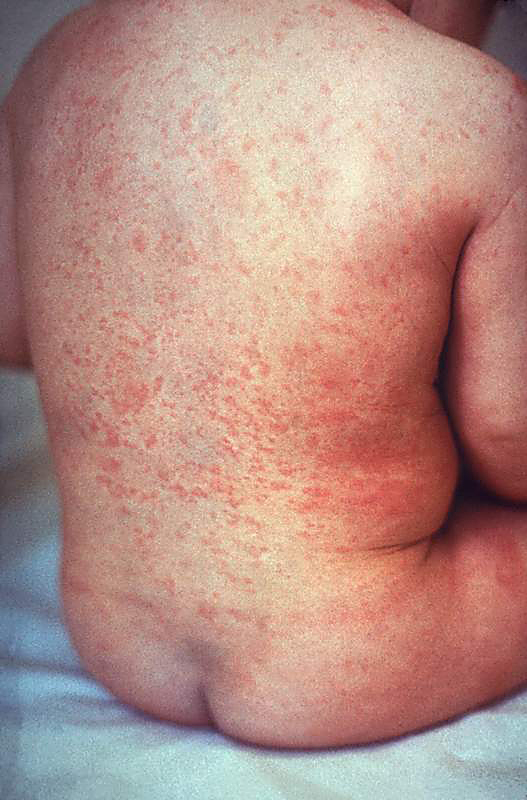 [Photo: Rubella rash on back of child.]Like several other viruses we’ve talked about, Rubella is an RNA virus. It’s a togavirus which has no known carrier states, meaning that the reason it’s still on the earth is because it easily finds susceptible humans to infect who then readily help it to find its next victim.
[Photo: Rubella rash on back of child.]Like several other viruses we’ve talked about, Rubella is an RNA virus. It’s a togavirus which has no known carrier states, meaning that the reason it’s still on the earth is because it easily finds susceptible humans to infect who then readily help it to find its next victim.
Rubella occurs worldwide and tends to peak during the spring in countries with temperate climates. Before 1969 (when the vaccine was introduced) there were pandemics every 6-9 years in the US and 3-5 years in Europe.
It infects humans of any age (preferring the 5-9 year old group) through the respiratory route and does its replication in the nasopharynx and lymph nodes; although it can be found in the urine, feces and on the skin.
There is a range of presentations and can be very mild so as to pass almost unnoticed. It can last one to three days or it can last up to a week. It has an incubation period (time before symptoms show up) of 2 to 3 weeks during much of which it can be transmitted to others. The virus is found in the blood 5 to 7 days into the infection and spreads throughout the body.
An infected person with Rubella is contagious for a WEEK BEFORE the rash, all during the illness and for a WEEK AFTER the rash. That is, if there even is a rash. If not, all bets are off and virus is spread without even knowing what you had.
When the virus is in the blood, it can readily pass through the placenta of a pregnant woman and infect the developing fetal tissues. Infection within the first 20 weeks of pregnancy results in the Congenital Rubella Syndrome (CRS), if the fetus survives – miscarriage occurs in up to 20% of cases.
An infant with CRS can still have active virus persisting for several months after birth, which makes them a significant source of infection to other infants and, more importantly, to pregnant female contacts.
The Acquired Disease
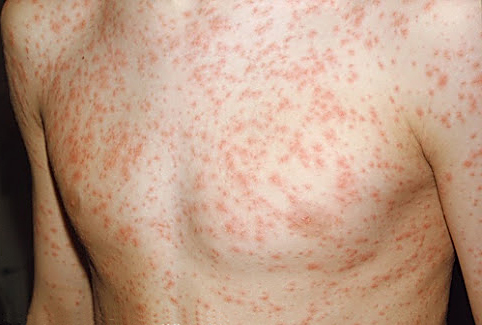 [Photo: Boy with Rubella rash on chest and arms.]Becoming infected is as easy as coming in contact with someone who looks well… or has a rash… or not. Respiratory and mucus droplets, urine, fecal contamination and skin could all be the source and the virus begins multiplying rapidly in the lymph tissues.
[Photo: Boy with Rubella rash on chest and arms.]Becoming infected is as easy as coming in contact with someone who looks well… or has a rash… or not. Respiratory and mucus droplets, urine, fecal contamination and skin could all be the source and the virus begins multiplying rapidly in the lymph tissues.
For one or two weeks it grows and can even spread to others, then causes a low grade fever and “flu-like” symptoms (maybe) before producing its pinkish rash on the face and neck. It causes tender swollen glands all over the body which is almost the hallmark of the disease. The rash spreads to the trunk and extremities, lasts for 1-3 days then disappears along with the lymph node tenderness.
However, the skin may (or may not) peel and the swelling of the nodes can last several weeks. Other symptoms like joint pain, headache and conjunctivitis are inconsistent. The older a person is, the more severe the symptoms are likely to be; and, for some reason, up to 60% of older girls and women experience joint pain or arthritic type symptoms with rubella.
The Forchheimer’s dots (seen in FIRST disease) can also occur fleetingly on the soft palate in 20% of Rubella cases – i.e. small, red papules on the area of the soft palate. And, although rare, serious problems such as brain infection and bleeding problems can occur.
The congenital Disease (CRS)
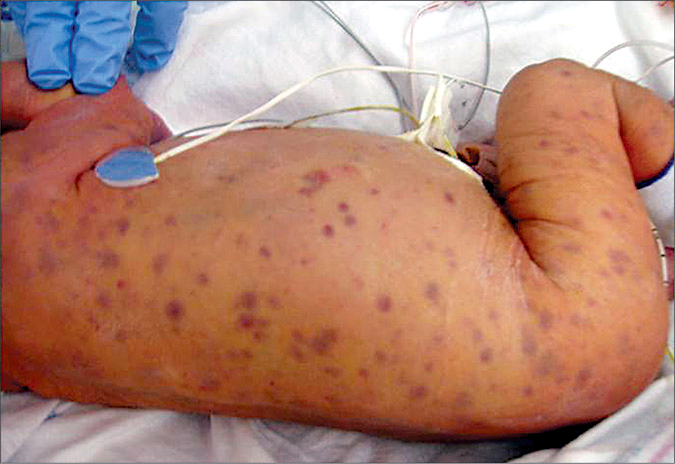 [Photo: Infant with “Blueberry Muffin” skin lesions of congenital Rubella]The congenital disease, however, is as bad as the acquired form is normally mild. The virus spreads throughout the body in the blood stream which makes developing embryonic tissue in the uterus a prime target for its mayhem.
[Photo: Infant with “Blueberry Muffin” skin lesions of congenital Rubella]The congenital disease, however, is as bad as the acquired form is normally mild. The virus spreads throughout the body in the blood stream which makes developing embryonic tissue in the uterus a prime target for its mayhem.
Even though the placenta does a remarkable job in filtering out a lot of toxins, it can’t stop the Rubella virus which will stop cell development or cause miss-development in many different organ systems.
Of course the fetus is particularly susceptible in the first 20 weeks of gestation and can miscarry or abort. If the baby survives, it is born with defects in many different organ systems, including: prematurity, low birth weight, anemia, hepatitis and bleeding disorders.
The skin manifestations are called “blueberry muffin lesions” and are pathognomonic of congenital Rubella virus infection. There can also be heart defects (i.e. patent ductus arteriosus), blindness, deafness and other life threatening organ disorders.
CRS is the main reason a vaccine for rubella was developed and the fact that most of you have never seen a baby born with this (or even dare to question whether or not to get the shot) is solely attributed to the tremendous success of the huge effort to inoculate the worlds population.
In the developed countries, obstetric physicians are almost obsessive about ascertaining the Rubella Titer (amount of antibodies to the Rubella virus) of women and giving the appropriate vaccinations. The standard MMR given to the rest of the population cannot be given in pregnancy so instead they are given a single vaccine.
Treatment – Cure
There is none! Control of the disease relies entirely on prevention and eradicating susceptibility through vaccination.
Management is a matter of responding to symptoms which may diminish discomfort. Treatment of newly born babies is focused on management of the complications.
The Rest Of The Story
The story of Rubella, the devastation it caused and the success of the eradication program, should at least be mentioned as one of the true world-wide successes of modern medicine.
Not the first vaccine developed, nor the hardest, but one marking an era in medicine where a particular devastating disease was targeted for eradication and accomplished, almost.
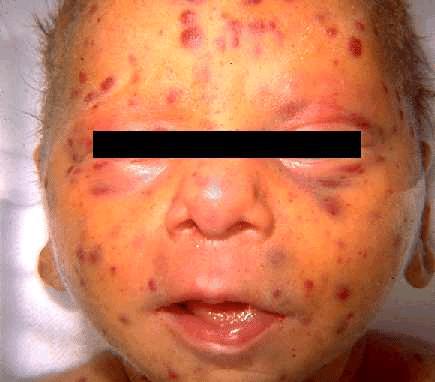 [Photo: Face of infant showing the “Blueberry Muffin” skin of CRS]After an epidemic of Rubella in Australia in 1940, an ophthalmologist discovered that 68 of 78 babies born with cataracts came from mothers who had caught Rubella in early pregnancy. His report to the profession described a host of problems now known as CRS and observed that the earlier the mother was infected, the worse the damage done to the baby and was the beginning of the search for a “cure.”
[Photo: Face of infant showing the “Blueberry Muffin” skin of CRS]After an epidemic of Rubella in Australia in 1940, an ophthalmologist discovered that 68 of 78 babies born with cataracts came from mothers who had caught Rubella in early pregnancy. His report to the profession described a host of problems now known as CRS and observed that the earlier the mother was infected, the worse the damage done to the baby and was the beginning of the search for a “cure.”
A world-wide pandemic of Rubella began in 1962 in Europe and spread to the US through 1965. The US had an estimated 12.5 Million cases leading to 11,000 miscarriages or abortions and still left 20,000 cases of CRS. Of these, 2,100 died in the neonatal period, 12,000 were deaf, 2,580 were blind and 1,800 mentally retarded.
In those same years (1964-65) New York alone had 1% of all its births affected by Rubella.
In 1969 a live attenuated virus vaccine was licensed. In the early 1970s, a triple vaccine containing attenuated measles, mumps and rubella (MMR) viruses was introduced and interrupted transmission of Rubella in the Americas!
No endemic case has been observed in the US since February 2009 due to universal immunization and a high level of “herd” immunity – which is critical in this disease due to all the things I described above.
On January 22, 2014, the World Health Organization and the Pan American Health Organization declared and certified Colombia free of the rubella and became the first Latin American country to abolish the disease within its borders.
In the UK, there is reported to be a large population of men who have not been vaccinated and are therefore susceptible to rubella. Outbreaks still arise around the world, usually in developing countries where the vaccine is not as accessible, which make it highly important to maintain vigilance in vaccination.
Rubella infection of children and adults is usually mild, self-limiting and often asymptomatic. The prognosis in children born with CRS is poor.
8 Posts in Numbered Diseases (numbereddiseases) Series
- Part 7 - Roseola – 27 Apr 2014
- Part 6 - Erythema Infectiosum – 15 Apr 2014
- Part 5 - Filatov-Dukes disease – 3 Apr 2014
- Part 4 - Rubella – 26 Mar 2014
- Part 3 - Scarlet fever – 18 Mar 2014
- Part 2 - Measles – 10 Mar 2014
- Part 1 - Numbered diseases of childhood – 2 Mar 2014
- Childhood Rashes and Numbered Diseases: Intro/Index – 1 Mar 2014
Advertisement by Google
(sorry, only few pages have ads)

